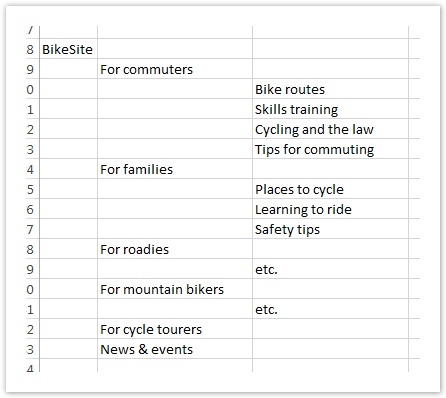...
To illustrate this, let’s imagine two designers, Tom and Maria, who are creating both asked to design a medium-size content websites website for cycling – say about 300 pages of well-designed, clearly written information.
...
Having studied the content and talked to the site’s internal stakeholders, Tom thinks a lot, then opens a new spreadsheet and creates a text tree of possible headings and subheadings, based on the various types of activities topics that the site offers.
...
A day or two later, another idea occurs to him, so he creates another tree based on different types of audiences:
...
He adds a few questions here and there where he needs to check ideas and terminology with the other project members.
When he reviews his structural tree ideas with others on the team, they make comments and suggestions, and he accordingly makes a few revisions. Most of them prefer the audience-based tree, which he is also leaning towards, so he goes with that design for the actual website.
Everyone is happy until several weeks after the site is released. The analytics show that certain parts of the site that expected heavy traffic are getting very little, while the web-feedback channel is choked with users complaining they can’t find this or that on the new site. (They love the new look and feel, but it’s much harder to find things now that everything has changed.) This feedback persists for several months.
...
"Way too much work to find what I want. Maps used to be all in one place, but now they're scattered all over the place." - a disgruntled site visitor
Eventually, a consultant is brought in to do some usability testing on the site and recommend fixes. One of the major issues she finds is that the site is organized in a way that makes sense to the project team, but not to one some of their two major audiences. Some of this can be fixed with simple terminology changes, but some of it will require fundamental changes to the site structure, which will in turn require a good deal of content rework.
No one (including Tom) wanted this result, but now that they know about it, it can be fixed in release 2 . New features will have to wait until later, (if they can get funding .
- quote from project manager about having to redesign navigation in v2
...
for it).
"We were hoping to add a stolen-bike registry next, but that will have to wait until we solve some basic navigation issues." - site owner
Maria and the empirical method
Like Tom, Maria starts by studying the content and talking to the site’s internal stakeholders. She also And, like Tom, her initial instinct is an audience-based scheme.
She asks about any existing user research, and receives the results of a site survey done the previous year, which suggests some new content but doesn't give any clues to better ways to organize the site.
She has some ideas on how to structure the content, but she also knows that she is not the target audience, so she decides that she needs to get some user input to help generate structure ideas. She runs an open card sort online using some representative content, and discovers that most users actually organize the cards according to activity, not according to audience. Her initial hunch was wrong, but it’s easy to change direction this early in the game.
...

